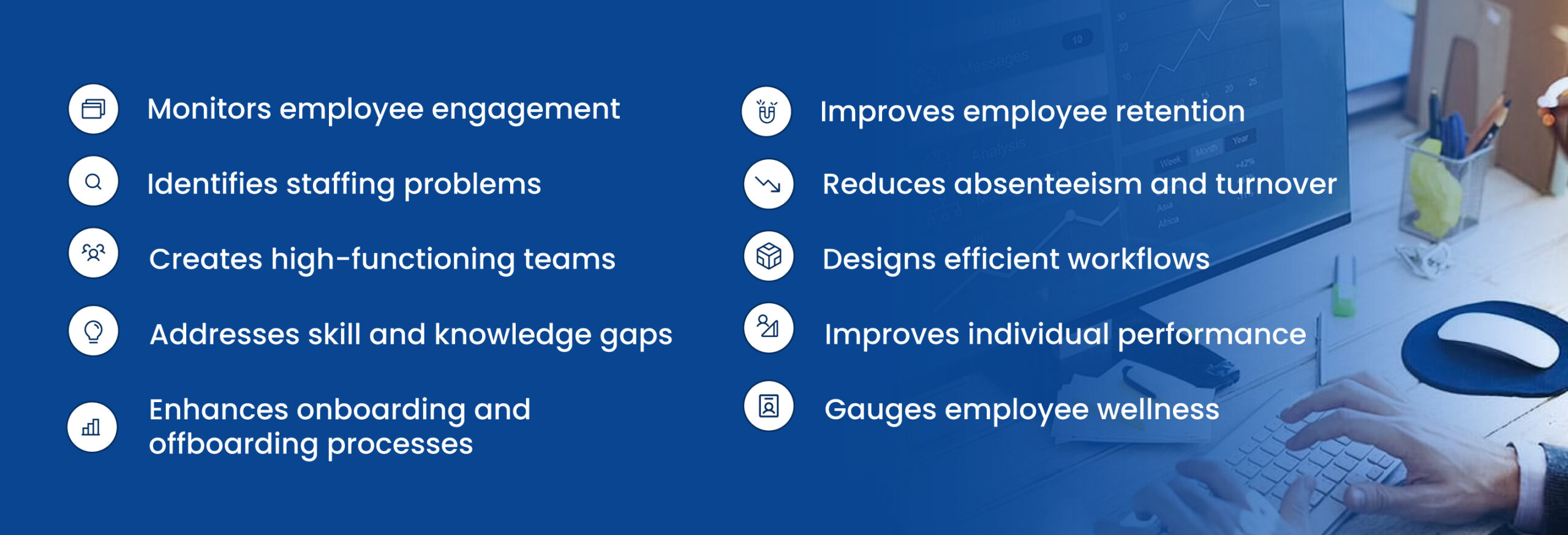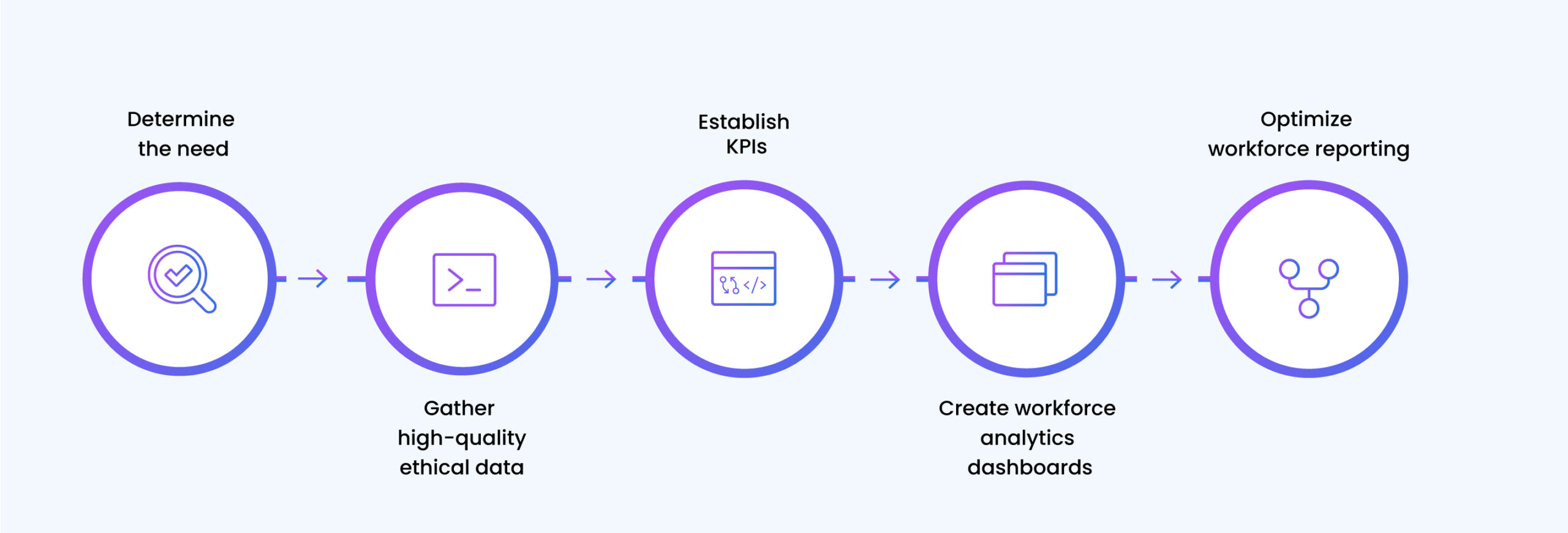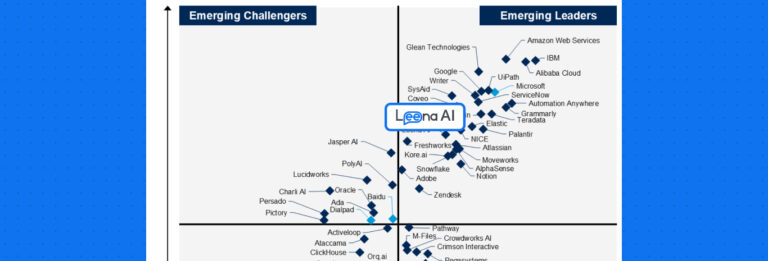It is no secret that the human resource industry is evolving rapidly. The adoption of HR tech has acted as a catalyst in the growth of the HR industry, and it isn’t slowing down anytime soon. Owing to the widespread adoption of HR technology, the traditional model of a “human resource” department is getting replaced by a new approach to managing people: workforce analytics.
Workforce analytics uses data to make better decisions about employees, and it is quickly becoming the norm in businesses everywhere. Companies that do not use HR workforce analytics are missing out on opportunities to reduce employee turnover, increase productivity, and improve employee satisfaction—all things that have a huge impact on their bottom line.
The steady growth in the workforce has compelled HRs to make data-informed decisions. Be it around ensuring appropriate staffing in the current environment or planning for a new normal of work trends: workforce analytics is critical to help HRs make informed decisions on a strategic level.
This blog showcases how HR tech helps organizations make better decisions with workforce analytics.
What is workforce analytics?
Workforce analytics is an advanced set of data analysis tools and metrics that helps HRs measure the performance of their workforce. It provides HRs an entire picture of different processes, including recruitment, staffing, training and development, and compensation and benefits processes. Workforce analytics provides insights into how well these processes work together to meet organizational goals.
HRs can leverage these insights to make better decisions on the utilization and allocation of resources for enhanced efficiency and effectiveness in the organization.
Managers can also benefit from this data in assessing their teams’ strengths and weaknesses. This way, they can identify high-performing employees and promote them as and when the time comes. Other ways HRs can use workforce analytics include understanding the impact of change in staffing on organization-wide performance.
What are the different types of workforce analytics?
Workforce analytics is classified into three categories: predictive, diagnostic, and prescriptive. Below is a detailed description of each to help you understand how and when to use them:

Predictive analytics
Predictive analytics leverages data to predict outcomes based on patterns in historical data. It digitally digs through data to extract, analyze, and categorize information to identify patterns, irregularities, and correlations.
Predictive analytics predict future employee performance based on their past performance. It is helpful, especially for managers who need to make decisions about hiring and retention based on their current needs. It also provides insights for improving your business processes, which ultimately will help you increase revenue and decrease costs.
Diagnostic analytics
Diagnostic analytics identifies the reason behind any event/activity taking place. For example, factors leading to attrition, and poor productivity. It helps in analyzing the root causes of problems and determining the best possible ways to address them.
Prescriptive analytics
Prescriptive analytics uses data from both predictive and diagnostic analytics. It helps in making better decisions by recommending actions based on findings, such as trends or patterns in employee performance over time (which could indicate a decline in productivity). The analysis often includes suggestions for process improvements or other changes that can positively impact business outcomes.
How does workforce analytics benefit organizations?

Workforce analytics is the key to helping organizations manage their most valuable resource: employees. Here are some of the core benefits of workforce analytics:
Monitors employee engagement
One of the most important metrics for assessing how well an organization is doing is by measuring employee engagement. A high employee engagement score ensures higher productivity, lower turnover rates, and better organizational performance. So, it’s essential for organizations to keep track of their employees’ engagement levels and identify factors that drive or hinder this metric. Workforce analytics helps organizations measure the same.
Using workforce analytics, organizations can monitor different aspects of employee engagement. They can:
- determine whether employees are happy with their current job
- understand why some employees are dissatisfied with their jobs
- measure how well managers are performing in relation to their teams
- identify areas where training or development could make a positive impact on performance
By tracking employee performance and productivity, employers can identify those areas where employees are underperforming and not meeting their goals. It allows them to pinpoint the cause of their underperformance and address those issues before they go out of hand.
Identifies staffing problems
Workforce analytics identifies and resolves staffing problems to ensure that your employees are working efficiently. Staffing problems are grave issues and can impact your bottom line. In fact, according to the Staffing Industry Analyst (SIA), staffing problems cost companies an average of $26,511 annually in lost productivity and increased turnover costs.
Fortunately, organizations can overcome the staffing problem by leveraging workforce analytics. Workforce analytics gathers data from multiple sources to help organizations address bottlenecks. These sources include performance evaluations, employee engagement surveys, timekeeping records, and more to get a clear picture of how well their employees perform and whether or not they have enough staff to meet their organizational demands.
Workforce analytics allows organizations to find gaps in the skill sets or areas of expertise of employees to reduce redundancies in the workforce. It lets organizations reassign employees to tasks where they will be able to flourish and do their best work, ultimately producing better results for the company!
Creates high-functioning teams
Workforce analytics empowers organizations to create high-functioning teams. It gives managers the tools they need to understand their staff—from their strengths and weaknesses to their work styles and personalities—and then build teams that can be productive.
With workforce analytics, companies can:
- identify performance gaps within their teams
- determine how each employee works best
- create a culture of accountability by assigning specific tasks based on the strength of each employee
This information can help boost productivity and efficiency in several ways. It can help identify patterns, like which type of employees are most likely to leave or why certain groups are having trouble collaborating.
Addresses skill and knowledge gaps
Workforce analytics is a new way to address the skill and knowledge gaps in today’s marketplace. It allows organizations to understand how their workforce performs, and how they can improve the performance through training, mentorship programs, etc. The result is an engaged and productive workforce with access to all the tools they need to succeed.
For example, if a particular team has a high turnover rate, it may be because they lack specific skills or knowledge that other teams possess. The HR teams can use workforce analytics to determine the required skills for that team and accordingly arrange training sessions.
Enhances onboarding and offboarding processes
One of the biggest challenges in onboarding and offboarding is to make the process as smooth as possible for employees. The longer it takes for an employee to get up to speed, the more time they spend on training, and the less time they spend doing their actual job.
A great way to improve onboarding and offboarding is through workforce analytics. By analyzing workforce data, you can streamline the onboarding process by providing new hires with all the information they need when they start work.
It includes:
- identifying where your current workflow is facing issues so that you can improve onboarding
- keeping track of which training programs are most effective at helping new employees become productive members.
- figuring out how long it takes for new and existing employees to get up to speed with their work.
Improves employee retention
Organizations can use workforce analytics to gain insights into the factors responsible for higher attrition rates and take corrective measures to boost employee retention.
For example, if employees leave at a higher rate than expected, it may be because of inadequate compensation or because they feel unappreciated by management. In such scenarios, employers can offer salary increases or conduct exit interviews with departing employees to find the actual issues.
Other measures that enterprises can take to improve employee retention is providing learning and development opportunities to employees who want to upskill and grab growth opportunities within the organization.
Reduces absenteeism and turnover
Another use case of workforce analytics is that it helps organizations track absenteeism. If enterprises notice that some employees take more sick leaves than others, or the same people are often absent on workdays, it indicates stress in their personal lives or at work, and they may be considering leaving your company soon. Use this information as an early warning sign and offer your employees additional support to help them stay with your company longer.
Designs efficient workflows
Workforce analytics helps design efficient workflows. It is especially true for businesses that operate in a highly transactional environment, such as retail stores or restaurants. Workforce analytics enables business owners to understand how employees spend their time and how much effort they spend on tasks, to ensure that employees are always performing at their peak efficiency.
For example, if your company is growing rapidly, workforce analytics can help you understand how many employees you will need in the future and how many hours they will need to work each week or month.
Improves individual performance
The ability to track and analyze employee performance is critical today. It helps companies understand what they need to do differently to retain their best talent and how they can better support lower-performing employees in their roles. It is where workforce analytics comes in.
Workforce analytics determines every employee’s performance, strengths, weaknesses, and ways to boost their performance. Organizations can use this information to reorganize the workforce such that each employee leverages their full potential in the given role for optimal results.
It will help employees feel more fulfilled in their jobs and will result in higher productivity overall.
Gauges employee wellness
Companies are increasingly using analytics to measure employee wellness and productivity. But what does that mean?
Well, it is pretty simple: companies want to measure how employees feel and perform. They can do this by keeping track of things, like, their work hours, productivity levels, and even their sleep patterns.
The idea is that if organizations can measure their employees’ wellness, then they can take adequate measures to improve it. Employers can take preemptive measures before an employee reaches a point where they feel like leaving their job is the only solution for them, personally or professionally.
How to implement workforce analytics?

Implementing the workforce analytics program requires support from employees who understand your goals. Take a thoughtful approach to growing trust and transparency among employees while aligning them to the goals of the program.
Here are a few key aspects you need to keep in mind while implementing workforce planning and analytics in your organization:
Determine the need
One of the first steps in implementing workforce analytics is to ask yourself why you want to do it. You need to figure out the business outcomes you want to achieve. Post that, you can chart a course for solving the problems of your workforce. It not only helps you build a robust action plan but also garners support from key stakeholders in the organization.
Gather high-quality ethical data
Gathering high-quality and ethical data is the first step to implementing workforce analytics. Ethical data collection means obtaining consent from individuals and organizations before collecting their information and ensuring that your organization adheres to all relevant regulations regarding privacy, security, and other data protection rights.
Establish KPIs
Before you implement workforce analytics, you need to have clear goals and objectives in place. For example, if your organization wants to reduce the turnover rate, you should track the rate at which employees leave their jobs.
Setting KPIs will help you determine your workforce analytics success or failure. If a KPI is not being met, it might be the time to tweak how things are getting done altogether.
Create workforce analytics dashboards
Creating workforce analytics dashboards is necessary for the journey to a more efficient workforce. These dashboards help in understanding the utilization of the company resources, roles getting filled, and areas that need more attention. Organizations can use this information to make better-informed decisions about hiring practices, employee training programs, and organizational structure.
Optimize workforce reporting
The final step to implementing workforce analytics is to optimize workforce reporting. You can use workforce analytics reports to interpret data with clear project recommendations and provide clarity to project sponsors and implementation managers. It will ensure everyone understands who is responsible for outcomes.
Bottom line
As the HR industry continues to grow, it has become increasingly important for HR professionals to find ways to increase their efficiency and productivity. Leena AI is a platform that aims to help HRs do just that by providing them with an employee experience suite.
The AI-powered employee experience platform allows organizations to analyze and make sense of the data they have collected over time, all in one place. It helps them make better decisions about how their company should move forward for hiring, training, or any other HR-related area.
Book a demo today to see how Leena AI can help your business make data-driven decisions and improve workforce efficiency.






